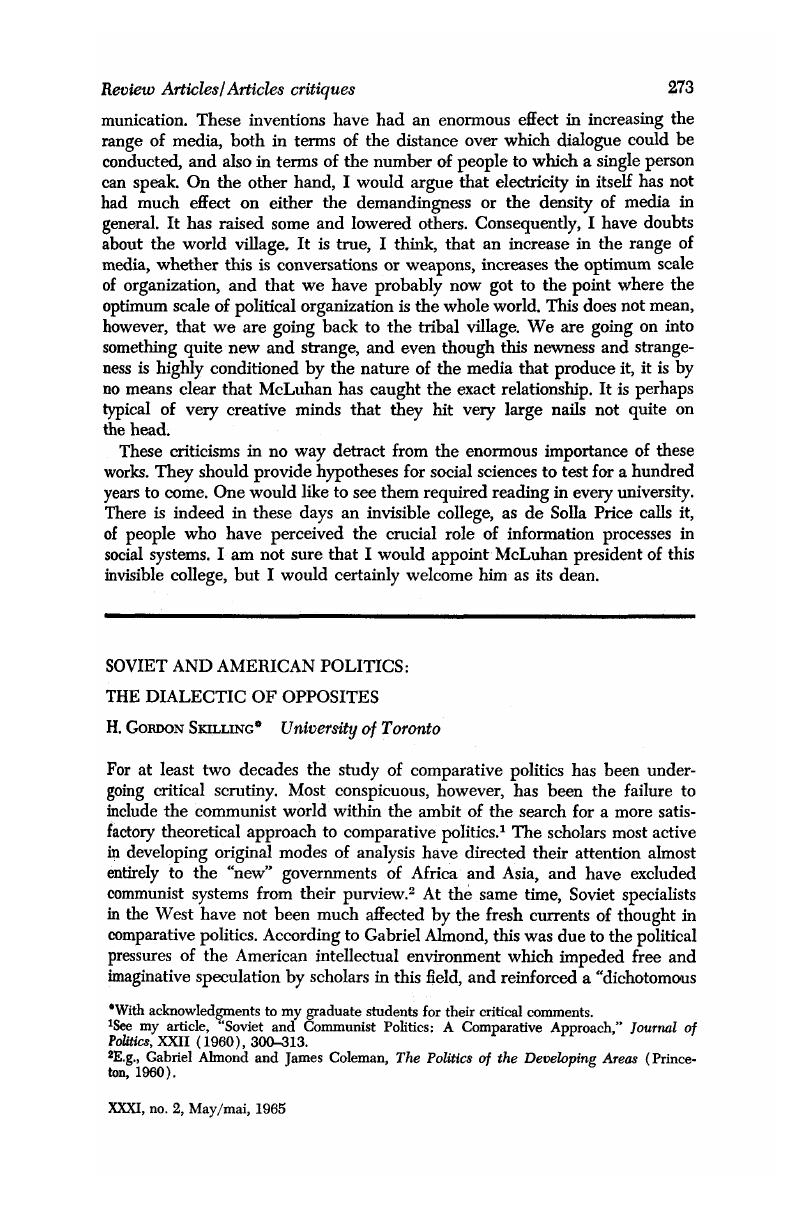Published online by Cambridge University Press: 07 November 2014

1 See my article, “Soviet and Communist Politics: A Comparative Approach,” Journal of Politics, XXII (1960), 300–313.Google Scholar
2 E.g., Almond, Gabriel and Coleman, James, The Politics of the Developing Areas (Princeton, 1960).Google Scholar
3 An address before the Conference on Soviet and Communist Studies of the American Political Science Association (not published), Sept. 10, 1964.
4 New York: Viking Press [Toronto: MacMillan]. 1964. Pp. 461. $9.25.
5 Structure of Nations and Empires (New York, 1959), ix, 6.Google Scholar At many points in his book, Niebuhr notes striking similarities between Soviet and other societies (35, 217, 233–4).
6 See for instance, Conquest, Robert, Power and Policy in the USSR (London, 1961), 11–14 Google Scholar; Fainsod, Merle, How Russia Is Ruled (2nd ed., Cambridge, Mass., 1963), 386–7, 417–20CrossRefGoogle Scholar; articles under the title “How Strong is Khrushchev?” by Linden, Carl, Rigby, Thomas, and Conquest, Robert, Problems of Communism, XII, no. 5 (09–Oct., 1963)Google Scholar, and by Carl Linden, Robert Tucker and Wolfgang Leonhard, ibid., no. 6 (Nov.-Dec, 1963). Almond and Coleman warned against the polarization of analysis of totalitarian and democratic systems (Politics of the Developing Areas, 49; also 23–5, 41). Note the comment by Nove, Alex, in “The Uses and Abuses of Kremlinology,” Survey, no. 50 (01 1964), 175–6.Google Scholar
7 No. 3, March, 1961, 210–11. In private discussions with Soviet scholars, the author discovered a more receptive attitude towards the comparative approach. See “In Search of Political Science in the USSR,” this Journal, XXIX, no. 4 (11 1963), 523–4.Google Scholar
8 (1st ed., New York, 1944. ) The two nations revealed, he argued, “a series of most striking similarities, psychologically, culturally and socially” (161), and were “steadily converging towards a similar type of social organization and economy” (208), Even in the political field Sorokin observed a basic similarity. Cf. the wartime speech by Vice President Henry Wallace on the similarities of the USA and the USSR, published in Prefaces to Peace (N.Y., 1943), 376–81.Google Scholar In a more recent article, entitled “Mutual Convergence of the United States and the U.S.S.R.,” in the International Journal of Comparative Sociology (09 1960), 143–76Google Scholar, Sorokin maintains his position, arguing the fact of convergence in twelve areas, including the political.
9 (New York, 1947), 113. Cf. the remarks of Strachey, John, “On the Prevention of War,” as published in the Observer (London), 01 7, 1963 Google Scholar, where he argued the tendency for the economic and social systems of the advanced industrialized states to approximate one another, and predicted that, given time, there would be convergence in the political systems.
10 The Transformation of Russian Society (Cambridge, Mass., 1960)Google Scholar, especially the conclusion.
11 See his article, Soviet Studies, XII, no. 4 (04 1961).Google Scholar Also Boettcher, Erik, Die Sowfetische Wirtschaftspolitik am Scheidewege (Tübingen, 1959), 278–96Google Scholar, and the review of this book by Schlesinger, R., Soviet Studies, XII, no. 2 (10 1960), 205–11.Google Scholar Other economists have differed on the degree of convergence. See for instance The Soviet Economy: A Discussion (London, 1956)Google Scholar, by Raymond Aron, Colin Clark, and others. Peter Wiles has sharply criticized the convergence theory in “Will Capitalism and Communism Spontaneously Converge?,” Encounter (06 1963), 84–90.Google Scholar
12 See “Russia and the United States: A Problem in Comparative Sociology,” in Allen, P. J., ed., Pitirim Sorokin in Review (Durham, N.C., 1963), 225–46.Google Scholar Inkeles stresses the opposed character of the political and economic systems, but in an analysis which depicts the American scene largely in terms of pure democratic theory, rather than political reality (ibid., 231–43). See also Inkeles, Alex and Bauer, Raymond A., The Soviet Citizen (Cambridge, Mass., 1959).CrossRefGoogle Scholar
13 Soviet Marxism (New York, 1958), esp. 4–6, 81, 185–91, 195, 228, 239, 258.Google Scholar
14 Cited by Kerblay, Basile, in Survey, no. 50 (01 1964), 103–4.Google Scholar
15 Contained in Ehrmann, Henry W., ed., Interest Groups on Four Continents (Pittsburgh, 1958).Google Scholar